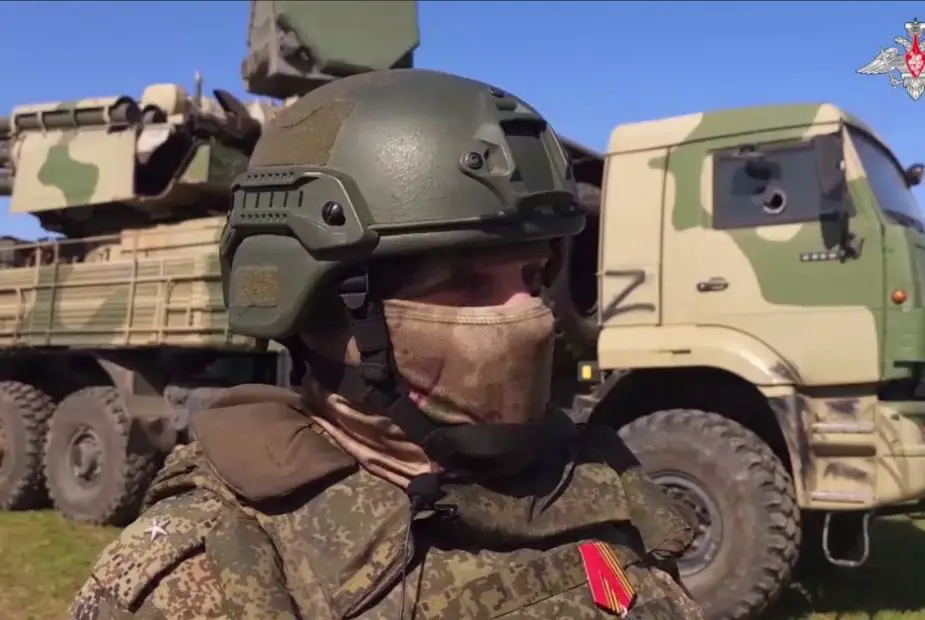Russian Pantsir-S1 Air Defense System Originally Intended for Iraq Spotted in Eastern Ukraine
In a recent video released on April 20, 2024, by the Russian Ministry of Defense and available on the VK social network, a Pantsir-S1 air defense system sporting an unusual camouflage pattern was highlighted. This specific model appears to be a re-export version intended for the Iraqi armed forces, a development that has emerged as exported models were previously spotted in the Ukraine conflict zone, highlighting the complexities of international arms agreements.
Follow Army Recognition on Google News at this link

Russian Pantsir-S1 in camouflage for Iraq, March 2024, Eastern Ukraine. (Picture source: Russian MoD )
According to the Stockholm International Peace Research Institute (SIPRI), the arms contract signed between Iraq and Rosoboronexport, a Russian agency, in 2012 included the delivery of 30 combat helicopters such as the Mi-28NE and Mi-35M, along with 24 Pantsir-S1 systems, with an option for an additional 24 units. While over 20 units were delivered to Iraq in 2016, and another batch in 2018, it remains unclear how a unit from this contract ended up in service with the Russian armed forces. It is likely that this unit remained the manufacturer's property after an early cancellation of the contract, and was later transferred to the Russian Ministry of Defense.
The 2012 arms deal was nearly interrupted due to a corruption scandal involving Iraqi officials. Despite these controversies, Iraq received the export version of the Pantsir-S1E system, which, while similar to the original model in technical specifications, does not include the usual "friend-foe" radar recognition system and may incorporate Western electronic components.
The Pantsir-S1, designed by the KBP Instrument Design Bureau in Tula, Russia, and manufactured by the Ulyanovsk Mechanical Plant, is a complex system aimed at protecting military areas and strategic industrial targets. First introduced at the MAKS Air Show in Zhukovsky near Moscow in 1995, this system combines surface-to-air missiles and automatic cannons to protect against precision air attacks at low and very low altitudes.
The mobile configuration of the Pantsir-S1 includes up to six combat vehicles per battery, surface-to-air guided missiles, 30 mm rounds, a transporter-loader vehicle for every two combat vehicles, and maintenance and training facilities. The United Arab Emirates was the first export customer, ordering 50 Pantsir-S1 systems in 2000, mounted on MAN SX 45 8x8 wheeled vehicles, in a deal worth $734 million.
The system is armed with twelve 57E6 or 57E6-E guided missiles and two automatic 30 mm 2A38M cannons, developed from the GSh-30 cannon. This armament allows it to engage tactical aircraft, subsonic cruise missiles, and high-speed air-to-ground missiles, with a maximum range of 20 km and an altitude of 10 km for aircraft. The Pantsir-S1 is also capable of operating in a passive mode using an infrared channel, logically processing the signal and automatically tracking targets.
Mobility is another strength of the Pantsir-S1, which can be mounted on various truck chassis such as the Ural-5323 or the Kamaz 6560, and is capable of moving at speeds of up to 100 km/h on roads. This mobility allows it to be rapidly deployed and to operate across diverse terrains, from desert expanses to challenging mountainous areas.
Its ability to engage two targets simultaneously and to attack up to 12 targets within a minute, combined with an adaptive radar/optical weapon control system, makes the Pantsir-S1 highly effective against a wide range of aerial threats. The system is designed to be resistant to jamming and to survive in environments with electronic countermeasures and under enemy fire.
However, American military analysts have highlighted potential vulnerabilities in the Pantsir-S1 system, particularly its strong reliance on radar for target identification, which advanced electronic warfare tactics could compromise. Despite these concerns, the system has been widely adopted and is currently used by several countries, including Algeria, the United Arab Emirates, Syria, Iran, Oman, and Vietnam. Each of these nations values the Pantsir-S1 for its ability to fortify its airspace against various threats.
Defense News April 2024
- Hits: 3333
















